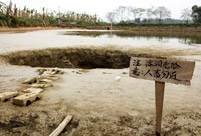


SHANGHAI, April 15, 2016 -- This aerial photo taken on March 29, 2016 shows a view of the free trade zone in Shanghai, east China. China's GDP stood at 15.9 trillion RMB yuan (2.4 trillion U.S. dollars) in the first quarter this year, growing up by 6.7 percent year on year, the National Bureau of Statistics said on April 15, 2016. (Xinhua/Ding Ting)
BEIJING, April 15 -- China's economy continued to slow in the first quarter of 2016, official data showed on Friday, but several key indicators pointed to signs of stabilizing.
The country's GDP grew 6.7 percent year on year to reach 15.9 trillion yuan (2.4 trillion U.S. dollars), according to the National Bureau of Statistics (NBS).
The growth further narrowed from the previous quarter's 6.8 percent, which was already the lowest quarterly rate since the global financial crisis.
However, the figure was in line with market expectations and remained within the government's targeted range of between 6.5 and 7 percent for 2016.
New growth momentum is gathering and some major indicators have seen positive changes, NBS spokesperson Sheng Laiyun told a press conference, calling the first-quarter performance "a good start" to this year.
PICKING UP
Fixed-asset investment rose 10.7 percent year on year in the first quarter, a faster expansion than last year's 10 percent. Investment in the property sector grew 6.2 percent, accelerating from 1 percent for the whole of 2015.
Industrial output expanded 5.8 percent, up from the 5.4-percent increase for the January-February period.
The service sector grew 7.6 percent, outpacing a 2.9-percent increase in the primary industry and 5.8 percent in the secondary industry. It accounted for 56.9 percent of the overall economy, up 2 percentage points from a year earlier, Sheng said.
A prolonged industrial glut, sagging foreign trade and cooling property investment dragged down China's growth in 2015 to 6.9 percent, the slowest pace in 25 years.
Authorities have taken a string of measures to mitigate the downshift, cutting interest rates, reducing taxes, slashing overcapacity and initiating reforms to improve efficiency.
Thanks to those moves, the economy has seen some improvement since the beginning of this year, with exports and industrial profits returning to growth, manufacturing activity picking up and power use accelerating.
Louis Kuijs of Oxford Economics described the first-quarter deceleration as milder than many had feared. The stronger growth momentum will continue in the second quarter, he wrote in a research note.
Earlier this week, the International Monetary Fund raised its forecast for China's growth in 2016 and 2017 to 6.5 percent and 6.2 percent respectively, both up 0.2 percentage points from its January predictions.
CAN IT LAST?
Sheng said there are signs of China's economy "bottoming out," but warned of persisting downward pressure due to uncertainty in the global economy and difficulties in the country's structural shift to consumption-driven growth and entrepreneurship.
It will take more time to tell if the stabilization can last, he acknowledged.
"China's future growth is likely to follow an L-shaped trajectory in the long run, but in the near term, it may present a U- or W-shape due to fluctuations," Sheng told reporters.
Despite the latest proof of improvement, headwinds from housing oversupply, high leverage and overcapacity reduction will persist over the rest of this year, according to analysis by Japanese securities trade Nomura.
A warming housing market contributed more GDP growth in the first quarter than it did a year earlier, but a huge overhang of unsold homes remains.
The more prominent share of services in the economy was a positive, but not a panacea for China's structural woes, as their output was artificially inflated by unsustainable growth of the financial sector, said Bloomberg economist Tom Orlik.
Meanwhile, reliance on lending to shore up growth raises concerns about longer-term balance.
Newly-added social finance, a gauge of funds that firms and households get from the financial system, amounted to 2.34 trillion yuan in March, up 1.51 trillion yuan from February, central bank data showed on Friday.
That speed of credit acceleration is not a sustainable trajectory in the medium term, but with growth stabilizing, the urgency to push ahead with monetary easing is reduced, Orlik said in a research note.
The Chinese economy is not yet on a firm path of recovery, given the uncertain outlook on the housing market and the export front, according to HSBC economist Julia Wang, who stressed the role of fiscal support pledged by authorities.
China aims at a deficit-to-GDP ratio of 3 percent for this year, up from 2.3 percent in 2015.
"If policy makers can deliver the promised fiscal easing, it will lift infrastructure investment, and put the recovery on a surer footing," Wang said.
 The evolution of J-10 fighter
The evolution of J-10 fighter Top 10 Asian beauties in 2016
Top 10 Asian beauties in 2016 What's happening in Xisha Islands?
What's happening in Xisha Islands? When female soldiers meet flowers
When female soldiers meet flowers North Sea Fleet conducts drill in West Pacific Ocean
North Sea Fleet conducts drill in West Pacific Ocean Old photos record the change of Sichuan over a century
Old photos record the change of Sichuan over a century Breathtaking aerial photos of tulip blossoms in C China
Breathtaking aerial photos of tulip blossoms in C China Horrific: Pit swallows 25 tons of fish overnight
Horrific: Pit swallows 25 tons of fish overnight Vietnamese Su-30 fighters fly over Nanwei Island in South China Sea
Vietnamese Su-30 fighters fly over Nanwei Island in South China Sea Top 20 hottest women in the world in 2014
Top 20 hottest women in the world in 2014 Top 10 hardest languages to learn
Top 10 hardest languages to learn 10 Chinese female stars with most beautiful faces
10 Chinese female stars with most beautiful faces China’s Top 10 Unique Bridges, Highways and Roads
China’s Top 10 Unique Bridges, Highways and Roads Student lottery strands young Chinese in US
Student lottery strands young Chinese in US Gay marriage ruling marks progress in societal openness
Gay marriage ruling marks progress in societal openness China watchdog cracks down on illegal live streaming platforms
China watchdog cracks down on illegal live streaming platforms North Korean restaurants face rocky future in China as sanctions bite, staff defect
North Korean restaurants face rocky future in China as sanctions bite, staff defectDay|Week